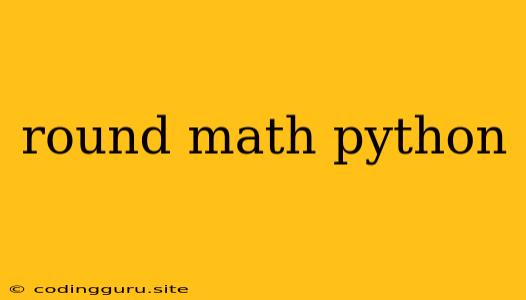Rounding Numbers in Python: A Comprehensive Guide
Python, a versatile and widely used programming language, provides various methods to round numbers. Rounding is a fundamental operation in various applications, from data analysis and scientific computation to financial modeling and everyday calculations. This guide will explore different rounding methods in Python, covering various scenarios and helping you choose the best approach for your specific needs.
Why Round Numbers in Python?
Rounding numbers in Python is essential for several reasons:
- Data Presentation: Presenting data with a large number of decimal places can be confusing and overwhelming. Rounding helps simplify data presentation by displaying only significant digits.
- Accuracy and Precision: Some applications demand precision, while others prioritize readability. Rounding allows you to control the level of accuracy displayed while maintaining the essence of the data.
- Mathematical Operations: Rounding numbers can be necessary during mathematical operations to avoid unnecessary decimal places and maintain consistency in results.
- User Experience: Presenting rounded numbers to users, especially in financial contexts, can improve user comprehension and avoid confusion.
Python's Built-in Round Function
The round() function is Python's native tool for rounding numbers. It offers the flexibility to round to a specific number of decimal places.
Basic Usage:
>>> round(3.14159)
3
>>> round(3.14159, 2)
3.14
Key Points:
round(number)rounds to the nearest integer, rounding halfway cases (e.g., 2.5) to the even number.round(number, ndigits)rounds tondigitsdecimal places.
Example Scenarios:
- Rounding to the Nearest Integer:
>>> round(2.7)
3
- Rounding to Two Decimal Places:
>>> round(3.14159, 2)
3.14
The math.ceil() and math.floor() Functions
For specific rounding behaviors, Python's math module offers ceil() and floor() functions.
math.ceil(x): Roundsxup to the nearest integer.math.floor(x): Roundsxdown to the nearest integer.
Code Example:
import math
>>> math.ceil(2.3)
3
>>> math.floor(2.3)
2
Applications:
- Ceil: Useful for scenarios requiring an upper bound or a minimum value.
- Floor: Useful for scenarios requiring a lower bound or a maximum value.
Rounding with decimal.Decimal
For precise rounding and control over rounding rules, use Python's decimal module. This module provides the Decimal class, which offers greater accuracy and customization compared to standard floating-point numbers.
Code Example:
from decimal import Decimal, ROUND_HALF_UP
>>> number = Decimal('3.14159')
>>> number.quantize(Decimal('0.01'), rounding=ROUND_HALF_UP)
Decimal('3.14')
Explanation:
Decimal('3.14159')creates a Decimal object.quantize(Decimal('0.01'))specifies the desired precision (two decimal places).rounding=ROUND_HALF_UPapplies the round-half-up rounding rule.
Rounding Considerations
When working with round(), remember:
- Tie-Breaking Rule: The
round()function follows a tie-breaking rule where numbers ending in .5 are rounded to the nearest even number. - Precision Loss: Standard floating-point numbers can introduce slight precision errors in rounding operations. The
decimalmodule mitigates this by providing greater accuracy.
Conclusion
Rounding numbers in Python is a fundamental aspect of data manipulation and presentation. Understanding the various methods, including the round() function, math.ceil() and math.floor(), and the decimal module, empowers you to round numbers accurately and efficiently. By choosing the appropriate method and understanding the implications of rounding rules, you ensure clarity and precision in your code and data analysis.
